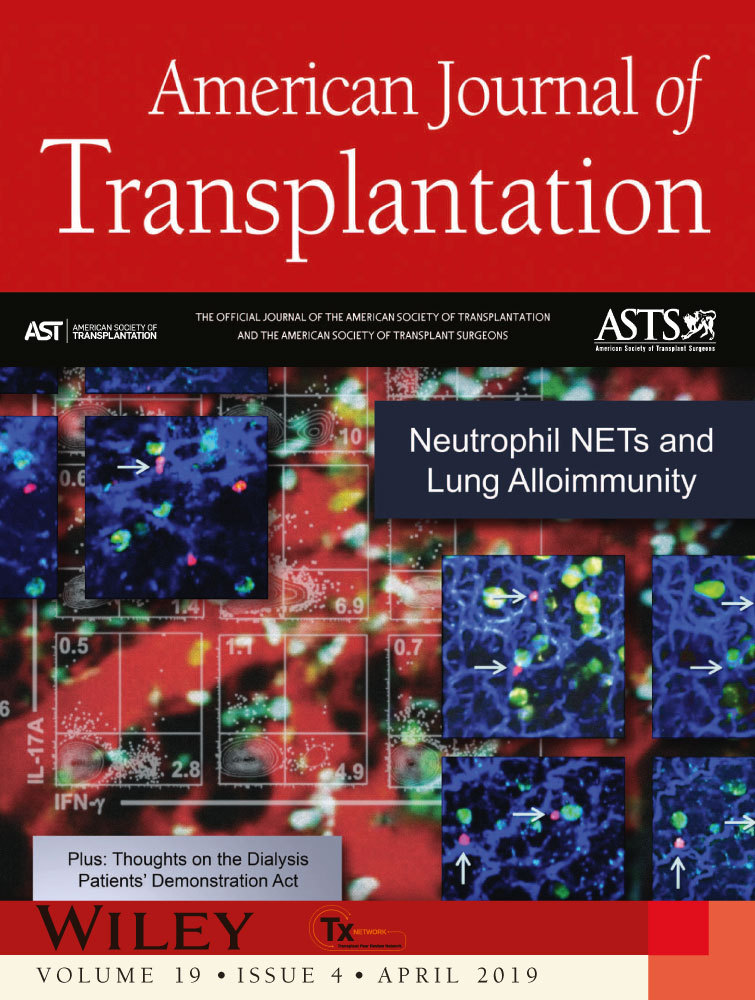Yes, we do need to demonstrate the survival advantage of pancreas after kidney transplantation
See also: Ventura-Aguiar et al
To the Editor:
We appreciate the comments and observations of the pancreas transplant team from Barcelona, Spain. In their letter to the editor entitled “Do We Still Need to Demonstrate the Survival Benefit of Pancreas Transplantation,” the authors do not contest the finding in our publication “The Survival Advantage of Pancreas After Kidney Transplant”1 that receiving a kidney followed by a pancreas provides a survival advantage over staying on the waitlist waiting for both organs. They were troubled by the long study period (1995-2010) during which time survival on dialysis and with transplantation have both improved with evolutions in techniques and practices, and the impact this may have had on our results and conclusions. Yet, in their summary statement, the authors also recommended that the focus should be on long-term outcomes beyond the first year. The reason we required such a long study period was actually so that we could achieve 10-year follow-up, satisfying their request.
The recommendation of the authors that living donor renal transplant (LDRTx) followed by pancreas after kidney transplant (PAK) should be pursued if the expected wait time for a simultaneous pancreas and kidney transplant (SPK) is more than 2 years seems reasonable, although the timing they suggest seems arbitrary. Data for kidney transplantation would suggest that the amount of time a candidate spends on dialysis waiting for a kidney has an impact on subsequent graft and patient survival after transplantation.2 Additionally, kidney transplant candidates with diabetes tend to have a much higher mortality risk while waiting than do candidates with other indications.3 The primary goal should always be to achieve independence from dialysis as soon as possible. If a simultaneous transplant can be done promptly, then this would be ideal. For example, at Indiana University it is a common practice to list the patients for an SPK and evaluate potential donors while they are waiting. If they are not near the top of the list, we proceed with LDRTx and PAK. Using this same logic, we are also inclined to accept 0 antigen mismatch kidney offers where the pancreas is not available or transplantable for candidates awaiting SPK with the plan for a subsequent PAK. So, PAK would offer the clear advantages of permitting earlier and potentially preemptive kidney transplantation, the patient and allograft survival advantages of a living donor kidney,4 and according to our current study the best long-term renal allograft survivals for both living and deceased donors. This is in addition to the societal advantages of allowing a standard criteria kidney to return to the deceased donor pool for another candidate who does not have a living donor.
We also read with interest the recent publication by the authors from Barcelona which they referred to in their letter.5 They indicated that their pancreas and patient survivals for LRDTx followed by PAK were inferior, but this was a small cohort of 18 patients that included 3 pancreas retransplants and 2 ABO incompatible transplants. There were 4 mortalities, all of which occurred more than 4 years posttransplant and half of which were in retransplant recipients. Other single-center studies have demonstrated opposing results with pancreas allograft and patient survivals approaching that of SPK,6 and with better renal allograft outcomes compared to receiving a kidney without a pancreas in suitable candidates for both.7 Data from the International Pancreas Transplant Registry also suggest similar patient survival and converging pancreas allograft survival when comparing PAK to SPK.8
We acknowledge that the long-term patient survival after PAK was slightly inferior to SPK and, as per the data provided in our article, was even inferior to that of kidney-alone recipients on the waitlist for a PAK. The Organ Procurement and Transplantation Network Pancreas Transplant Committee has previously released a guidance document on this topic, which included a similar analysis to that shown in Figure 3 of the current article but included a comparison of PAK to kidney recipients on the waitlist for PAK.9 In this analysis, unlike comparing to patients on dialysis, which showed a significant survival advantage for PAK, the difference was not significant up to 10 years of follow-up. Please note that these comparisons were to waitlisted patients, not all Type 1 diabetic recipients of renal transplants. This means that the waitlist mortality does not account for patients who were delisted prior to dying and therefore may be underestimated. There is also a lead time bias as PAK survival is measured from the time of pancreas transplantation, which was frequently years following the prior kidney transplant (median 657 days). This fraught comparison was, in fact, the major source of the ongoing controversy related to the prior publications from Venstrom et al.10 and Gruessner et al.,11, 12 and one that we intended to address in our recent publication.1 It was also this comparison that has essentially derailed PAK as a viable and acceptable alternative for the diabetic uremic candidate with a suitable living donor and was the primary motivation for repeating this analysis in order to demonstrate the survival advantage PAK provides compared to remaining on the waitlist and receiving neither a kidney nor a pancreas.
Disclosure
The authors of this manuscript have no conflicts of interest to disclose as described by the American Journal of Transplantation.




